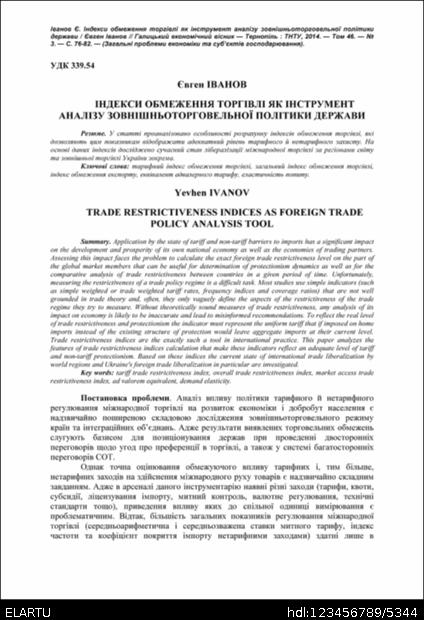このアイテムの引用には次の識別子を使用してください:
http://elartu.tntu.edu.ua/handle/123456789/5344

| タイトル: | Індекси обмеження торгівлі як інструмент аналізу зовнішньоторговельної політики держави |
| その他のタイトル: | Trade restrictiveness indices as foreign trade policy analysis tool |
| 著者: | Ivanov, Yevhen |
| Bibliographic description (Ukraine): | Іванов Є. І. Індекси обмеження торгівлі як інструмент аналізу зовнішньоторговельної політики держави / Євген Іванов // Галицький економічний вісник — Тернопіль : ТНТУ, 2014. — Том 46. — № 3. — С. 76-82. — (Загальні проблеми економіки та суб’єктів господарювання). Ivanov Y. Trade restrictiveness indices as foreign trade policy analysis tool / Yevhen Ivanov // Galician economic bulletin — Ternopil : TNTU, 2014. — Volume 46. — No 3. — P. 76-82. |
| 発行日: | 21-10月-2014 |
| Date of entry: | 16-12月-2014 |
| 出版者: | Тернопiльський національний технiчний унiверситет iменi Iвана Пулюя |
| Place of the edition/event: | Тернопіль |
| UDC: | 339.54 |
| キーワード: | тарифний індекс обмеження торгівлі загальний індекс обмеження торгівлі індекс обмеження експорту еквівалент адвалерного тарифу еластичність попиту tariff trade restrictiveness index overall trade restrictiveness index market access trade restrictiveness index ad valorem equivalent demand elasticity |
| 抄録: | У статті проаналізовано особливості розрахунку індексів обмеження торгівлі, які дозволяють цим показникам відображати адекватний рівень тарифного й нетарифного захисту. На основі даних індексів досліджено сучасний стан лібералізації міжнародної торгівлі за регіонами світу та зовнішньої торгівлі України зокрема. Application by the state of tariff and non-tariff barriers to imports has a significant impact on the development and prosperity of its own national economy as well as the economies of trading partners. Assessing this impact faces the problem to calculate the exact foreign trade restrictiveness level on the part of the global market members that can be useful for determination of protectionism dynamics as well as for the comparative analysis of trade restrictiveness between countries in a given period of time. Unfortunately, measuring the restrictiveness of a trade policy regime is a difficult task. Most studies use simple indicators (such as simple weighted or trade weighted tariff rates, frequency indices and coverage ratios) that are not well grounded in trade theory and, often, they only vaguely define the aspects of the restrictiveness of the trade regime they try to measure. Without theoretically sound measures of trade restrictiveness, any analysis of its impact on economy is likely to be inaccurate and lead to misinformed recommendations. To reflect the real level of trade restrictiveness and protectionism the indicator must represent the uniform tariff that if imposed on home imports instead of the existing structure of protection would leave aggregate imports at their current level. Trade restrictiveness indices are the exactly such a tool in international practice. This paper analyzes the features of trade restrictiveness indices calculation that make these indicators reflect an adequate level of tariff and non-tariff protectionism. Based on these indices the current state of international trade liberalization by world regions and Ukraine's foreign trade liberalization in particular are investigated. |
| URI: | http://elartu.tntu.edu.ua/handle/123456789/5344 |
| Copyright owner: | © „Галицький економічний вісник Тернопільського національного технічного університету“ |
| Content type: | Article |
| 出現コレクション: | Галицький економічний вісник, 2014, № 3 (46) |
このアイテムのファイル:
| ファイル | 記述 | サイズ | フォーマット | |
|---|---|---|---|---|
| GEB_2014v46n3_Yevhen_Ivanov-Trade_restrictiveness_76-82.pdf | 172,69 kB | Adobe PDF | 見る/開く | |
| GEB_2014v46n3_Yevhen_Ivanov-Trade_restrictiveness_76-82.djvu | 93,06 kB | DjVu | 見る/開く | |
| GEB_2014v46n3_Yevhen_Ivanov-Trade_restrictiveness_76-82__COVER.png | 187,95 kB | image/png | 見る/開く |
このリポジトリに保管されているアイテムはすべて著作権により保護されています。